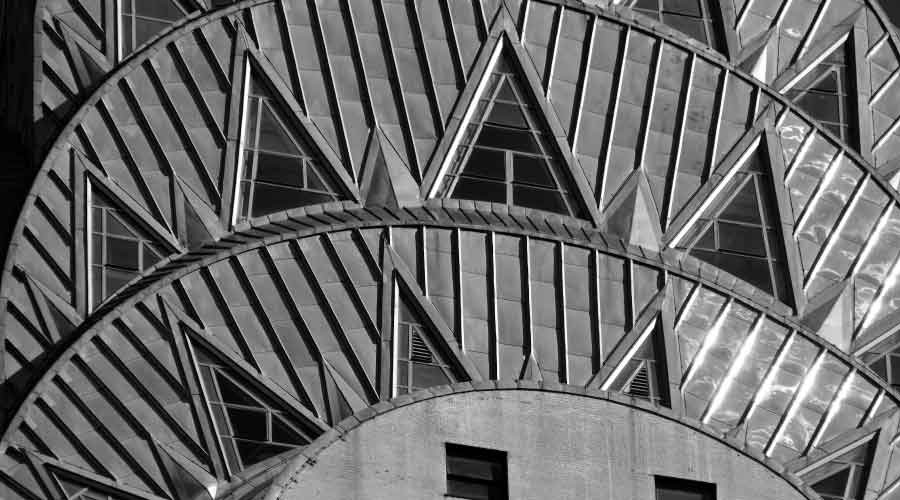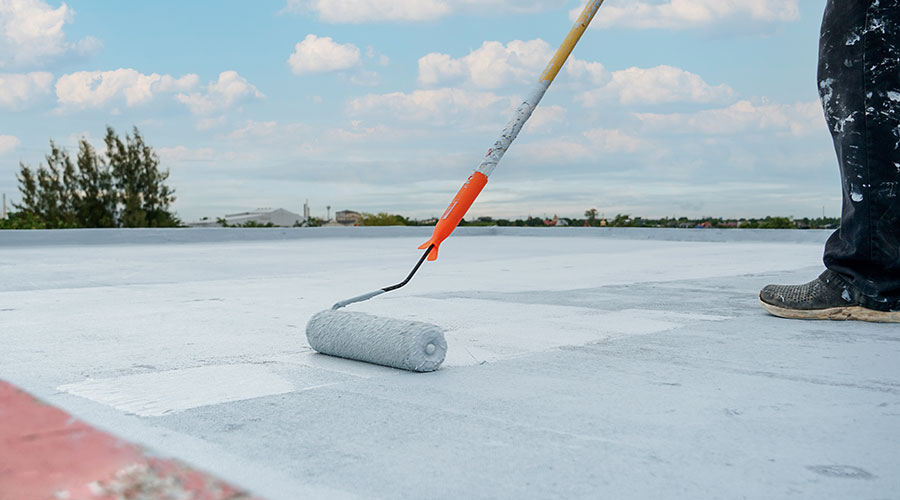 One of the more prominent examples of metal on a commercial building in the U.S., the Chrysler Building in New York City is topped with stainless steel panels on its upper floor arches.
One of the more prominent examples of metal on a commercial building in the U.S., the Chrysler Building in New York City is topped with stainless steel panels on its upper floor arches.Understanding the Benefits of Metal in Commercial Buildings
As a long-lasting, resilient material, and with a low environmental impact, metal roofing and wall systems are a smart choice for commercial buildings.
Metal cladding and roofs check many of the boxes for today’s building owners and facility managers. Metal is sustainable, durable, long lasting, resilient, and easy to maintain. As well, its metal products are available in a generous assortment of profiles, textures, styles, and colors. Metal panels lend a great aesthetic to schools, offices, recreational facilities, airports, municipal buildings and more.
As compared to other roofing materials, metal offers both the longest service life and lowest life-cycle cost. In a Ducker Worldwide research study, painted metal roofs posted an average service life of 41.6 years, as compared to 23 years for both modified bitumen and built-up roofing. Further, a peer-reviewed study sponsored by the Metal Construction Association and the ZAC Association showed a low-slope, unpainted, 55 percent AlZn-coated metal roof systems to have a service life of at least 60 years.
The upshot is building owners don’t have to spend a lot of capital improvement money to retrofit their roof. Rather, those funds be invested in other building improvements.
Not only are metal building’s long lasting, but they are extremely durable and resilient, often carrying warranties of 40 years or more.
Metal roofing systems are required to pass one of the most rigorous tests in the industry, E-1592, which injects a high level or air pressure between the panels. Because approved systems perform so well, they are highly recommended in areas susceptible to inclement weather.
A metal roof must also pass the UL 1897 test, which is used to evaluate the attachment of the roof covering systems to the roof decks by simulating negative pressures, and FM 4471 tests product performance for combustibility, wind uplift resistance, hail damage resistance, and foot traffic resistance.
“Metal roofing is in high demand in hurricane-prone regions due to its exceptionally long-lasting durability and protection against heavy rain, hailstones, and hurricane force winds,” according to the Metal Roofing Alliance.
Because metal roofing systems are designed with larger interlocking panels and fewer seams, as compared to other roofing systems, there are less areas for the wind to penetrate. If high winds do manage to start rattling around in between the metal covering and underlayment, metal’s ability to breathe and expand enables the roofing system to endure a certain level of air pressure. As a result, many metal roofs are rated to perform up to 150 miles per hour, which is the equivalent of a major Category 4 hurricane and an F2 tornado.
As a non-combustible material, metal will better withstand exposure to fire. For added resistance, metal systems can be coated or sprayed with fire-resistive materials. Combined with the fact that metal is resistant to mold, corrosion, and pest infiltration, this will lower a facility executive’s insurance premiums.
Sustainable Buildings
As a long lasting, recyclable, low maintenance material, metal has earned a place as one of the best cradle-to-gate building materials.
Not only is steel 100 percent recyclable, but according to the American Iron and Steel Institute, nearly 85 percent of steel is actually recycled, making it the most recycled construction material in the world. While other roofing materials occupy between 7 percent and 10 percent of the landfills, one would be hard pressed to actually find steel scraps in a landfill.
When recycled steel is used to produce new steel, less energy and water is required.
In a whole building life-cycle assessment study by Houston-based Walter P. Moore Associates, the environmental impact of metal buildings was found to be lower in case studies comparing structural and envelope materials to load-bearing concrete, masonry, tilt-up, and steel-framed construction within the same basic building footprint.
Metal building panels are also a highly insulating material capable of incorporating fiberglass or rigid board insulation of various thickness. This thermal insulation enables air conditioned buildings to stay cooler in the summer and heated buildings to stay warming in the winter by keeping thermal levels inside the building. This, in turn, significantly saves on heating and cooling energy consumption and cost.
Insulated metal panels (IMP), which are two metal panels sandwiched by an insulating foam core, offer even higher thermal levels. As compared to other types of insulation like mineral fiber, cellular glass, and expanded polystyrene, which offer an average insulating R-value of between R-3 and R-4 per inch, IMPs provide R-7 per inch or greater.
With today’s energy codes requiring building envelopes to be greater than R-40, IMPs enable facility executives to achieve these thermal requirements with thinner walls, thereby saving on construction costs and freeing up valuable real estate.
IMPs also offer the benefit of incorporating an air and water barrier within the system itself. This enables projects to more easily achieve a tight building enclosure which is key to energy efficiency and performance.
Another sustainability benefit of metal is that they can help a building be more energy efficient. Panels with special coatings make metal roofs highly reflective and capable of preventing a certain level of solar heat gain from penetrating the building. On sunny days, and particularly in the summertime, this significantly reduces indoor cooling levels and costs, and helps mitigate the urban heat island effect of heat buildup in urban environments.
According to the Lawrence Berkeley National Laboratory, on a typical summer afternoon, a cool roof that reflects 80 percent of sunlight will stay approximately 55°F cooler than a traditional roof reflecting just 20 percent. Depending on location and utility rates, for a 10 percent increase in roof reflectance, heating and cooling costs decrease $0.02/square foot per year.
One other unique way that metal roofing contributes to sustainable buildings is its compatibility with solar photovoltaic systems. In addition to its resilience and durability, as a long lasting material, it’s highly suited for solar products that have a service life of more than 30 years.
When making that kind of investment, building owners have no choice but to select a roofing system that will outlast the PV array. Incidentally, the only other roofing material with this type of longevity is natural slate, which is much heavier, only suitable for steep-slope applications, and costs five to 10 times as much as metal.
Construction Benefits
Compared to other materials such as brick or concrete, metal roofing and walls are relatively lightweight, thereby reducing the load on the foundations and structural framing requirements. Furthermore, installation proceeds at a quicker pace, thus reducing manpower and labor costs, and minimizing construction delays. Unlike other building materials, metal roofing and wall system construction can also continue through inclement weather conditions.
As a modular system, metal components are shop fabricated and arrive on-site ready for erection. This further reduces labor in addition to construction waste. For example, a 2,000-square-foot building framed in steel produces less than 2 percent leftover material, which can be recycled, compared to wood framing with 20 percent of its waste going to a landfill.
As more facility executives prioritize longevity, durability, resilience, energy efficiency, and sustainability, metal roofing and wall systems are a go-to choice for today’s commercial facilities.
Jeff Henry is executive director of the Metal Construction Association.
Related Topics:












